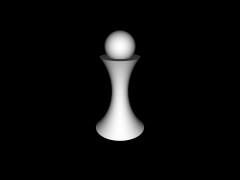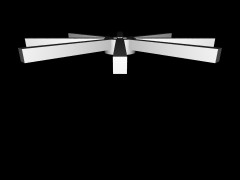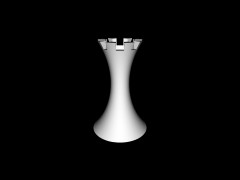---- DATABASE ERROR: 1 ---- Quick And Dirty: Building a CSG Chess Set
by Mike Kost
Introduction
Chess sets have always had their place in ray tracing, usually right
after the required sphere
over a checkered plane. Even beyond their use as beginning
first steps, chess sets are reoccuring props in other
Povray works.
To promote the advancement of chess sets everywhere, this Quick and
Dirty tutorial will show how to build a chess set using (mostly)
construction solid geometry (CSG) in Povray 3.6.
Quick Reading
In Povray, as in chess, it is best to study before making a move:
Beginning Design
Chess sets have a motif that runs through the whole set. Some sets hold
closely to this theme while others are barely recognizable except for
the base on each piece being similar. This chess set will have an
abstract style centered around the curvy center of a torus.

The stem is constructed by taking the difference of a box and a torus
as shown below. The translate is added to put the bottom of the stem at
y = 0.
difference {
box { 0.4, -0.5 }
torus { 0.8, 0.7 }
translate <0, 0.5, 0>
}
The Pawn
To construct the pawn, the lowliest of the chess pieces, a sphere is
added on top of the stem.

merge {
object { O_Stem }
sphere {
0, 0.17
translate <0, 1.01, 0>
}
texture { T_White }
}
The Rook
Rooks are taller than pawns and have castle battlement tops.
To get the effect, it's necessary to subtract off some material from
the stem. A cylinder will be used to hollow-out the top of the stem and
several boxes will be used to add the notched battlements. The
squares and cylinders are pictured below.

This structure is subtracted from a scaled up stem to produce
the
rook. Basic scripting was used to create the multiple boxes at regular
intervals instead of writing them all out.

difference {
object {
O_Stem
scale <1.1, 1.2, 1.1>
}
cylinder { 0.95*y, 1.1*y, 0.17 }
#local i = 0;
#while (i < 4)
box {
<-0.04, 1.0, -1>, <0.04, 1.1, 1>
rotate 45*y*i
}
#local i = i + 1;
#end
}
Copyright (C) 2006 Mike
Kost
